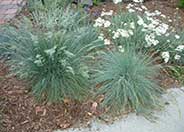
Common name:Blue Fescue
Botanical name:Festuca glauca
This ground cover/grass will grow less than 1' tall and has small, blue green leaves.
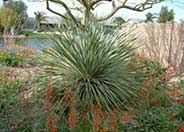
Common name:Spoon-Yucca
Botanical name:Dasylirion wheeleri
Spoon-Yucca requires little maintenance, as it tolerates drought, reflected heat and poor soils. It develops a short, thick trunk while reaching 6' tall and wide. Leaves are linear gray-green to 3' long and armed. During late spring and summer, erect stems of white creamy flowers are visible. It is a long lived shrub and slow-growing. It needs a well-drained site; it is cold and drought hardy.
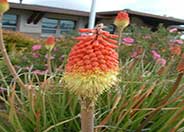
Common name:Red Hot Poker
Botanical name:Kniphofia uvaria
This perennial will reach about 3' tall and has large green leaves with orange flowers that bloom in summer and fall.
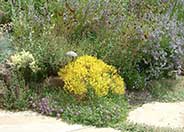
Common name:Ferned-Leaved Tickseed
Botanical name:Bidens ferulifolia 'Goldmarie'
Tickseed grows 14'-18" tall. It is a heat tolerant variety that is perfect for cascading, bright color in baskets, containers, and window boxes. Finely divided foliage is covered with gold, single flowers. It blooms until first frost. Plant in full sun. It needs well-drained soi.
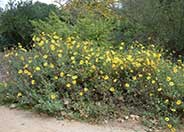
Common name:Coast Sunflower, Coast Encelia
Botanical name:Encelia californica
Encelia californica is a fast growing woody subshrub with bright green foliage and yellow daisy-type flowers. It can be used effectively in the natural landscape with regular pruning to maintain form. It is more commonly used in native restoration work. In inland situations, it requires more regular water. It grows to 3'-5' tall and 3'-5' wide.
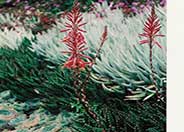
Common name:Gold Tooth Aloe
Botanical name:Aloe X nobilis
This succulent perennial will only grow 1' tall and 1' wide. It has large, sharp, dark green leaves and clusters of red-orange flowers that bloom in summer.
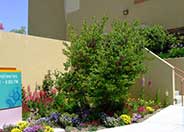
Common name:Western Redbud
Botanical name:Cercis occidentalis
This deciduous shrub ranges from 6'-20' tall and 10'-15' wide. It is desirable for its magenta spring flowers, yellow to red fall color, and dangling winter seed pods. It is tolerant of many soil types, drought and oak root fungus. It attracts hummingbirds and butterflies. The Western Redbud can be found statewide in CA in the foothills below 4500' elevations in chaparral and woodland communities.
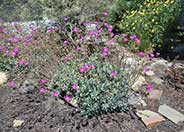
Common name:Rock Purslane
Botanical name:Cistanthe grandiflora 'Jazz Time'
This perennial will grow 12"-36" and produces large blue-green rosettes that last for a long season. It produces large, silky, lavender pink flowers that have lime-green, purple spotted calyces.
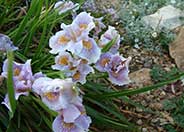
Common name:Pacific Coast Irises
Botanical name:Iris Pacific Coast Hybrids
These Irises are 6"-18" tall and have clumps of grass-like foliage. The flowers are 3"-4" across; it makes good cut flowers and vary from white, yellow, lavender, purple, blue, and reddish purple.
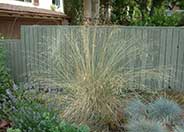
Common name:California Fescue
Botanical name:Festuca californica
The California Fescue is a cool season bunchgrass with blue green blades that reach 2'-5' high and 3' wide. Foliage arches gracefully upwards and outwards. Flower spikes reach 3' above the leaves. Plant in full sun or partial shade. It makes a great companion plant to oak trees and is handsome as a backdrop behind lower growing grasses for a meadow look. The California fescue is native to California and is a beneficial insect plant.
Using Water Wisely
An efficient watering system applies the right amount of water to the right parts of the garden at the right time. This conserves water and saves you money.
Click in the green box for more information
| Designer: The Plant Nerd | Med Front Right |
Photographer: GardenSoft |
Water Saving Tip:
Different areas of your landscape have different water requirements.
Shrubs need much less water than lawns and drip systems should never be scheduled on the same program with lawns.
Establish separate watering schedules for those areas.
